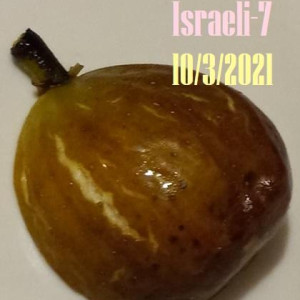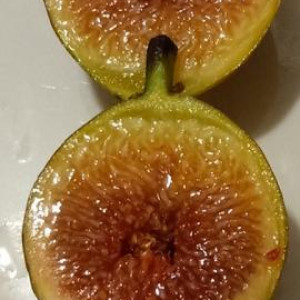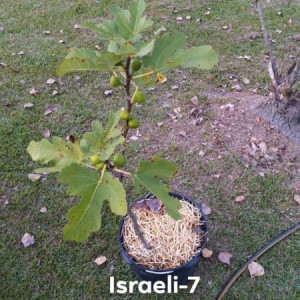This site contains affiliate links for which I may be compensated.
Israeli 7
Israeli 7 Information


-
Possible Synonyms / AKA:
Israeli 7 Unk., Israeli 7 Unknown
-
Introduced By:
Malcolm Heath -
Origin:
-
Main Flavor Group:
-
Family Group:
-
Fig Type:
-
Cold Hardy:
N/A -
Container Variety:
N/A -
Easy Rooting:
N/A -
Main Season:
mid -
Availability:
N/A -
Breba Crop:
N/A -
Seed Crunch:
N/A -
Eye:
N/A -
Skin Toughness:
N/A -
Fruit Size:
N/A -
Rain Resistance:
N/A -
Tree Vigor:
N/A -
External Links:
Description
𝐀 𝐅𝐢𝐠 𝐰𝐢𝐭𝐡 𝐚𝐧 𝐈𝐥𝐥𝐢𝐜𝐢𝐭 𝐒𝐭𝐨𝐫𝐲
This fig was originally acquired by Malcolm "Shaft" Heath's stepfather's friend over 40 years ago. He was travelling to Israel and stumbled upon this fig tree, and loved this fig so much, the best he had ever had, that he broke customs law to bring it back. Now, bear in mind, this is not just any man choosing to do a little bit of mischief. No, this was a pastor, on a missionary trip to the Holy Land, sneaking a single Cutting in his coat pocket on an international flight. "Around 25 years ago, my stepfather was given a Cutting of this tree and we eat from it to this day."
This fig was never identified by the pastor, what variety it is, or anything along those lines. You could consider this an Unknown variety because "Israeli 7" is simply a name Malcolm gave to it to identify it in contrast to other figs. Most of Israel is infected with Root knot nematodes ( RKN ). It is quite prevalent in their soils. You cannot get RKN from a Cutting , but it should be noted that this tree is heavily RKN -resistant like most wild figs from Israel. This tree shows no signs of wilting, yellowing, lessened harvest, or stunted growth due to RKN , and RKN is most certainly present.
This fig was originally acquired by Malcolm "Shaft" Heath's stepfather's friend over 40 years ago. He was travelling to Israel and stumbled upon this fig tree, and loved this fig so much, the best he had ever had, that he broke customs law to bring it back. Now, bear in mind, this is not just any man choosing to do a little bit of mischief. No, this was a pastor, on a missionary trip to the Holy Land, sneaking a single Cutting in his coat pocket on an international flight. "Around 25 years ago, my stepfather was given a Cutting of this tree and we eat from it to this day."
This fig was never identified by the pastor, what variety it is, or anything along those lines. You could consider this an Unknown variety because "Israeli 7" is simply a name Malcolm gave to it to identify it in contrast to other figs. Most of Israel is infected with Root knot nematodes ( RKN ). It is quite prevalent in their soils. You cannot get RKN from a Cutting , but it should be noted that this tree is heavily RKN -resistant like most wild figs from Israel. This tree shows no signs of wilting, yellowing, lessened harvest, or stunted growth due to RKN , and RKN is most certainly present.
𝐅𝐢𝐠 𝐅𝐥𝐚𝐯𝐨𝐫 𝐚𝐧𝐝 𝐂𝐡𝐚𝐫𝐚𝐜𝐭𝐞𝐫𝐢𝐬𝐭𝐢𝐜𝐬
The Israeli 7 fig tree produces a prolific crop of medium-sized, bronze-colored figs. The flavor of the fig in my humid climate begins with figgy flavor at the front, with a STRONG taste of honey in the body, followed by a hint of berry. The texture is far more syruppy than jammy, though there is some of that texture too. The skin is of moderate thickness, just shy of "biting into a baked good" like the Col DE Dames. Drips honey from the eye on drier days, does moderately well in humid climates but is severely drought-resistant. Of note is that I live in hot and humid North Carolina. Many honey figs wash out the honey flavor when supplied with too much rain. This has been the most extreme rainfall I can remember in my lifetime this year, and the honey flavor is still coming through strong, when my other honey figs not too far away are tasting rancid and mushy. I imagine these flavors would simply be heightened in a drier climate, with perhaps more berry. This fig also appears to be resistant to Root knot nematodes, like most wild figs from the Holy Land. (Israel's sandy soil is eaten up by Root knot nematodes). This is a great fig to eat fresh but I particularly enjoy it dried. It does tend to have a limited amount of splitting in humid climates. The eye remains tight throughout the year. It is a common type fig that produces a very minor Breba crop, if at all. The Main crop is quite prolific. Pollination by the fig Wasp is not required. This fig is quite reliable, producing a sizable crop every year once mature.
The Israeli 7 fig tree produces a prolific crop of medium-sized, bronze-colored figs. The flavor of the fig in my humid climate begins with figgy flavor at the front, with a STRONG taste of honey in the body, followed by a hint of berry. The texture is far more syruppy than jammy, though there is some of that texture too. The skin is of moderate thickness, just shy of "biting into a baked good" like the Col DE Dames. Drips honey from the eye on drier days, does moderately well in humid climates but is severely drought-resistant. Of note is that I live in hot and humid North Carolina. Many honey figs wash out the honey flavor when supplied with too much rain. This has been the most extreme rainfall I can remember in my lifetime this year, and the honey flavor is still coming through strong, when my other honey figs not too far away are tasting rancid and mushy. I imagine these flavors would simply be heightened in a drier climate, with perhaps more berry. This fig also appears to be resistant to Root knot nematodes, like most wild figs from the Holy Land. (Israel's sandy soil is eaten up by Root knot nematodes). This is a great fig to eat fresh but I particularly enjoy it dried. It does tend to have a limited amount of splitting in humid climates. The eye remains tight throughout the year. It is a common type fig that produces a very minor Breba crop, if at all. The Main crop is quite prolific. Pollination by the fig Wasp is not required. This fig is quite reliable, producing a sizable crop every year once mature.
July 2020, Pandemic-Season
My stepdad reminded me in July, seeing me get so interested in growing my own food, that we had a fig tree. I loved fig as a kid, but I'd only eaten from this tree once. I just didn't spend a lot of time outside. I was a computer nerd. I forgot about it for most of my life. I got a massively abundant harvest of some of the best figs I could imagine. I shared them with everyone. I dried a bunch with the dehydrator my stepdad gave me. I was in love. This particular tree was given to my stepdad when I was 5 years old, 25 years ago, and he planted it immediately. This was a rooted Cutting grown into a plant from the mother tree, which was itself a Cutting from a tree in Israel that my stepdad's friend, a preacher, had smuggled through customs from Israel. He thought the fig was so good he risked jail time to get it here.
My stepdad reminded me in July, seeing me get so interested in growing my own food, that we had a fig tree. I loved fig as a kid, but I'd only eaten from this tree once. I just didn't spend a lot of time outside. I was a computer nerd. I forgot about it for most of my life. I got a massively abundant harvest of some of the best figs I could imagine. I shared them with everyone. I dried a bunch with the dehydrator my stepdad gave me. I was in love. This particular tree was given to my stepdad when I was 5 years old, 25 years ago, and he planted it immediately. This was a rooted Cutting grown into a plant from the mother tree, which was itself a Cutting from a tree in Israel that my stepdad's friend, a preacher, had smuggled through customs from Israel. He thought the fig was so good he risked jail time to get it here.
If you'd like your banner to be shown here and throughout Fig Database, send us a message.
Photos Add Your Image
YouTube Videos
No Videos Found





















